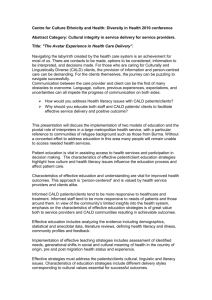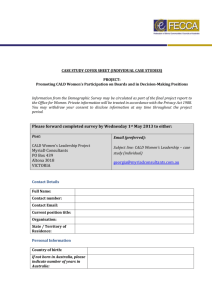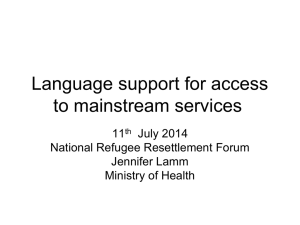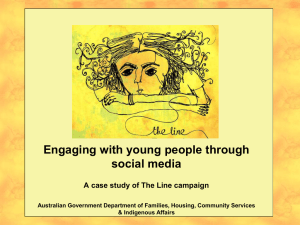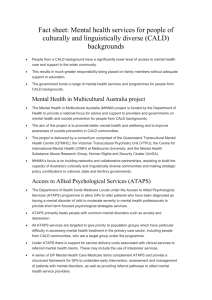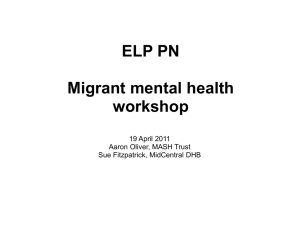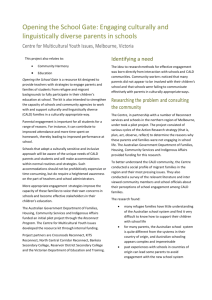Kim`s presentation - Centre for Culture Ethnicity & Health
advertisement
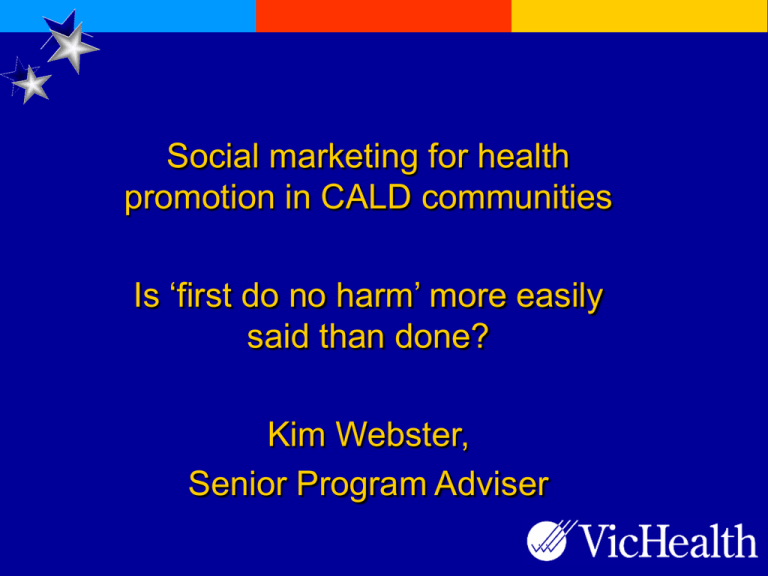
Social marketing for health promotion in CALD communities Is ‘first do no harm’ more easily said than done? Kim Webster, Senior Program Adviser What is social marketing? Social marketing is the systematic application of marketing along with other concepts and techniques to achieve specific behavioral goals for a social good. Campaigns and other methods of persuasion (community education, advocacy) About this presentation Draws on practice experience of VicHealth and its partners to: Highlight some of the unintended harms that may result from using social marketing approaches to promote health in CALD communities Discuss some lessons learned No ‘neat’ solutions but some principles Applications of social marketing in health promotion in CALD communities Behavior change (ether directly or by seeking to strengthen social norms): to improve individual self care (eg smoking cessation programs) to reduce the risk of harm to others in the community (eg programs to reduce drink driving) to reduce the risk of harm in personal relations (eg programs to prevent domestic violence, child abuse) in the ways people and organizations in the wider community treat people from CALD backgrounds (anti-racism, cultural awareness, more sensitive service provision) Messages to CALD communities can be delivered through specifically targeted programs or general programs designed to reach a diverse audience Targets for change Typically a social marketing campaign has a ‘primary target’ (the group of people whose behaviour the campaign is seeking to change) However the messages often reach other ‘secondary’ audiences (either intentionally or unintentionally) Potential risks Social marketing messages can have unintended negative impacts on: The primary target audience Groups other than the primary target Secondary influences may not always be a bad thing and may be a specific goal of the program. For example anti-smoking campaigns = development of broader social norms against smoking = increased commitment to take action on tobacco control Case study 1: primary prevention of violence against women Primary prevention involves preventing violence before it occurs Primary target is men (primary perpetrators and masculine socialization implicated as a causal factor) Effective approaches involve addressing gender inequalities and gender socialization and communicating that violence is unacceptable regardless of the circumstances Violence is not confined to CALD communities but emerging evidence indicates that it may be more prevalent (suggesting the need for greater resource allocation to these communities to address the issue). Accordingly, decision makers/service providers may be a secondary target. Case Study 1 cont; Risks in high-lighting the issue and/or possible higher prevalence in CALD communities Secondary audience risks Stigmatizing CALD communities and compounding marginal status Contributing to stereo-types of migrant men as patriarchal & women as ‘passive victims’ Compromising commitment to settlement of particular groups In the wider community - undermines understanding that the issue cuts across racial and ethnic lines (US mainstream campaign example) Primary audience risks Risks in a zero tolerance/gender equality approach: Disrupting social relations in already fragile communities May have little resonance with, and may alienate those from CALD backgrounds who have been subject to collective violence and marginalization prior to or following arrival Risks in NOT addressing the issue/selectively retreating from zero tolerance Equity? Is CALD women’s welfare any less important than the welfare of other women? CALD women are especially vulnerable – face the double jeopardy of sexism and racism (domestic violence markedly increases the risk of domestic homicide) Denial of the lived experience of CALD women/disempowerment Policy/program neglect Case study 2: Anti-racism Target is the wider community Evidence indicates that effective messages are those that emphasize commonality with minority ethnic groups Case study 2: Anti racism However this risks unintended harms to the secondary ethnic minority group audience as: Portrayal of minority ethnic groups in ways that are acceptable to the wider community may not be acceptable to groups themselves (eg emphasis on ‘food and dance’). Results in minority ethnic groups being accepted only on the terms of the wider community (thus compromising ethnic identity) Denial of ethnic identity now regarded as a form of racism itself. Has implications for health. Case study 3: Infectious disease and refugee trauma Early intervention critical Expert consensus that migrants and refugee present minimal risk to public health Campaign Targets: (a) new arrivals to encourage early and active help seeking (b) primary care workers to identify and take a more proactive approach with new arrivals Case study 3: Infectious disease and refugee trauma Unintended impacts (primary and secondary audiences) Moral panic and xenophobia Stigma Stereotyping as ‘weak or vulnerable’ Commitment to settlement of particular groups compromised Political considerations drive health service responses – risks over investigation, undermining of client autonomy Barriers to services Case study 3: Risks in NOT addressing the issue Undetected disease can be more complex and costly to treat and may be associated with reduced quality of life and productivity. May ultimately result in loss of life. Inadequate resource allocation Opportunities to sensitise services foregone Some principles to consider Consider impacts on other audiences and explore this in formative research with a view to addressing negative impacts where possible Assess risks and benefits – (but avoid planning to ‘worst case scenario’) Engagement of affected groups in developing messages and imagery Human rights or cultural relativism? Important in weighing up the potential harms to cultural integrity/ethnic identity Cultural relativism The belief that an individual’s beliefs and activities can be understood in the context of their own culture and that all cultural beliefs and practices are equally valid A human rights framework Culture is important and ought to be respected and preserved, but does not transcend basic human rights, in particular the right to safety and security. . Human rights or cultural relativism? Implications for message framing – the violence against women example In planning - acknowledging men’s context but not accepting it as an excuse for violence on the grounds that women’s human rights need to be similarly respected In message framing – use of messages that achieve the desired outcome while preserving important cultural values (and promoting these to the wider community) Using cultural reference points (beliefs, key opinion leaders) to demonstrate that violence is not acceptable Examples Spectrum Migrant Resource Centre video – ‘Family men don’t do family violence’ Northern Inter-faith Communities poster. Some principles to consider Plan to contain risk and maximize benefits Build political support for the campaign Cultivate leaders in both minority ethnic and wider communities to respond to problems (but also strengthen work!) Social marketing (alone) does not a health promotion program make! More information www.vichealth.vic.gov.au
